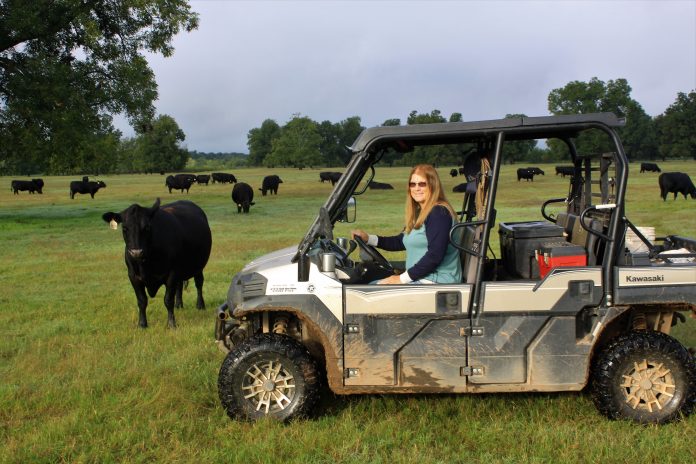story and photos by Bryan Painter
GRANT – The cliche is that time flies.
Cattlewoman Brenda Schulz, who ranches near Grant in southeastern Oklahoma’s Choctaw County, won’t argue that point.
However, two 100-year floods in 25 years is more like time sprinting rather than just marching on.
“Some of our toughest times have come from floods,” Schulz said. “Along with the wonderful aspects of having your farm and ranch in the fertile ground of the Red River comes the possibility of flooding. Curt and I have survived not one, but two, of the so called ‘100 year floods.’”
Guess what Schulz thanks for making it through those two experiences? Her cows.
Thanks to the cows
The first of those two floods Schulz is referring to came in 1990.
The May Monthly Summary that year from the Oklahoma Climatological Survey reported that the agricultural-related floods losses exceeded $57 million.
“We had leased farm ground that completely flooded,” Schulz said. “We survived, mainly due to the diversification our cattle provided. Our cattle pastures were up on the prairies around Soper, Oklahoma at this time.”
Then came the floods of 2015.
Gary McManus, state climatologist with the Oklahoma Climatological Survey, said that after being really dry for the first four months of the year, 2015’s “Super El Nino” ended up inundating far southeastern Oklahoma in May and June, and then again in November and December.
“That area near Grant in Choctaw County ended with their wettest year on record, with most of that rain falling within a select few weeks during those four months,” McManus said. “In other words, it was way too much water, concentrated into very short time frames, for the local rivers and reservoirs to handle.”
Schulz said the Red River overflowed its banks and half of their ranch flooded in May. She’s lived in Oklahoma long enough to have seen droughts turn dreams to powder. So she doesn’t curse the rains, she just respects them.
“After the water receded enough to flow within its banks again, areas north and west of us received a lot more rain and the Red River overflowed its banks once again in June,” she said. “We were not able to grow grain crops on our farm ground that year, it was too late in the season and the cows needed it for pasture. The cows have helped us survive those trying times.”
A small world
Schulz witnessed/experienced agriculture from a lot of different geographical viewpoints before landing in Oklahoma in 1984.
Not only did she grow up in North Dakota, she studied animal science at the University of Minnesota and worked with a veterinarian in Colorado where she met her husband Curt. They married in 1983 and a year later moved to Choctaw County, where his parents Delvin and Delores Schulz farmed and ranched.
“We started a beef cow herd as soon as we could,” Brenda Schulz said. “I loved being back around cows and horses. Curtis was custom farming and spraying. We rented farm ground and raised corn and soybeans.”
That was the start.
Today, 34 years after settling down in Choctaw County, they raise Angus cattle, corn, small grains, hay and pecans on 1,500 acres along the banks and in the bottoms of the Red River, south of Grant.
Schulz believes it was meant for her to live here, farm here and ranch here. Why?
Even though she was raised in North Dakota, Choctaw County is within 45 miles of her father Tom Secrest’s birthplace. Her grandfather was a sharecropper cotton farmer around Deport, Texas.
“He decided to settle his young family in east Texas when my grandparents’ wagon broke down, crossing Red River slate shoals,” she said. “These shoals are within 10 miles to the east of Stoneybroke Ranch, which is Curtis’ and my farm and ranch. It’s really a small world. I believe I have come back to my roots.”
Those roots are extending as daughter Kylee and son-in-law Keith Edge (superintendent of Boswell Schools), along with grandsons Kollin, 16, Kamden, 14 and Kolson, 12, take care of their cow/calf operation. They also help out at Stoneybroke Ranch with projects ranging from laying water lines to checking cattle.
Listen close
Cattle and horses aren’t something Schulz just tends to, she cares for them. That was evident as a child when she was around her parents breeding operation of Paints and Quarter Horses. It was evident in what she studied in college and then in the job she took working for the veterinarian. It was evident in how she gives credit to cattle bringing their operation through the floods.
It’s still evident today, especially if you listen real close during certain times of the year.
“In the spring, the cows are calving and all the babies are testing their legs, running and playing,” she said, adding that they tag and vaccinate every calf within 24 hours of birth. “I get to talk to and check the cows for new calves.”
Yes, “talk to.” What do you say?
Schulz said she would softly say something like, “You sure had a pretty baby, didn’t you? Good Mama!”
It is an enjoyable experience like that, that makes time fly at a comfortable pace.














